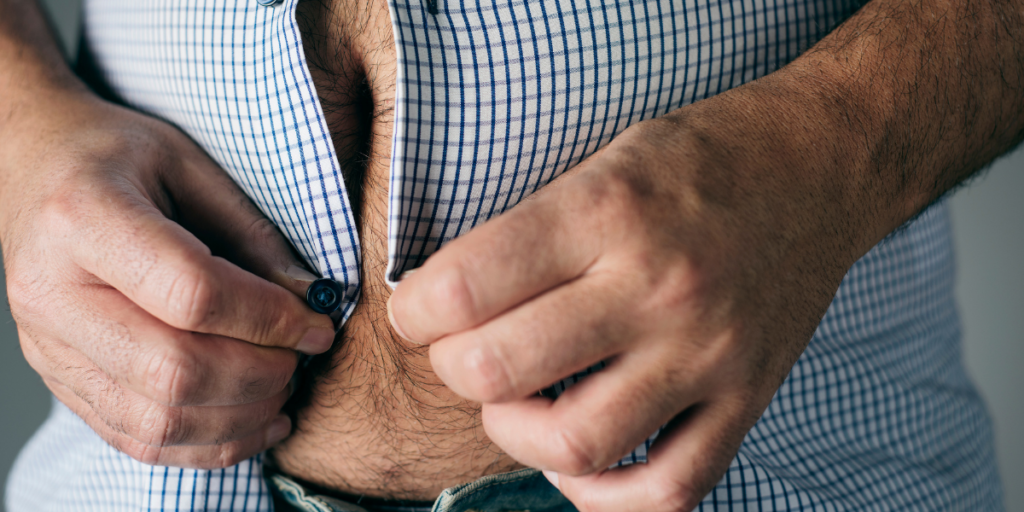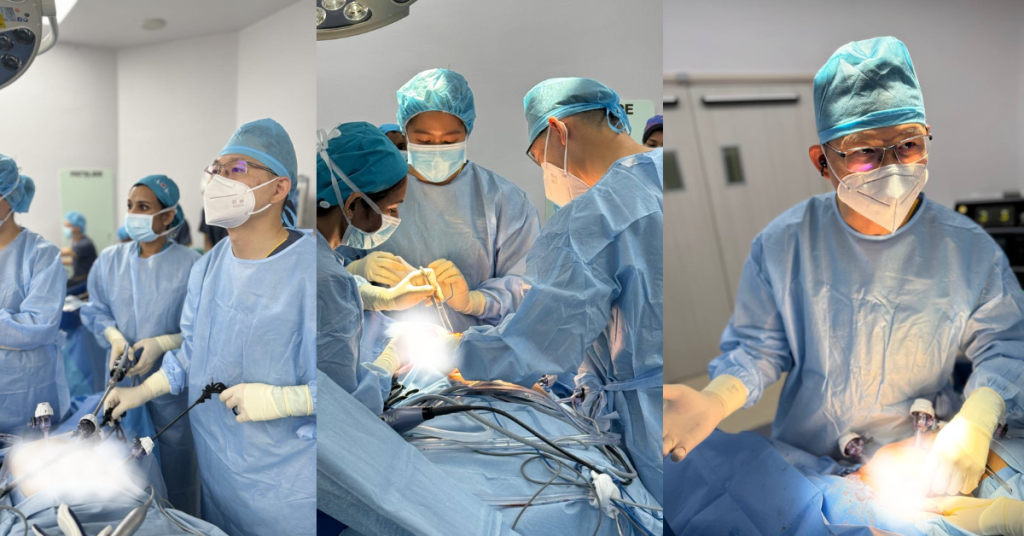What is an Inguinal Hernia?
A hernia happens when tissue from inside the body pushes through a weak spot in the muscle wall, creating a bulge.
An inguinal hernia is the most common type, making up about 75% of all abdominal wall hernias. It occurs when a part of the intestine or fat from the abdomen pushes through an opening in the lower abdominal wall, near the groin.
This usually happens due to a weakness in the abdominal muscles, which may be present from birth or develop over time. Increased pressure in the abdomen—caused by heavy lifting, chronic coughing, straining, or obesity—can worsen it.
There are two types of inguinal hernias:
While not always dangerous, inguinal hernias don’t go away on their own and may need surgery if they cause pain or complications.
Direct Inguinal Hernia
This type of hernia develops later on in life as a result of muscle weakness. It penetrates directly through the wall of the inguinal canal.
It is more common in older adults, namely men.
Indirect Inguinal Hernia
This form of hernia is more common in younger people, often due to a natural opening that did not close properly after birth.
Indirect inguinal hernias enter the inguinal canal from the top.
Fun fact: indirect inguinal hernias occur more often on the right!
Who is at Risk?
Some individuals have a higher risk of developing an inguinal hernia due to genetic or lifestyle factors, including:
- Family history – Those with a family history of inguinal hernias are 4 times more likely to develop one.
- Men – 90% of inguinal hernia cases occur in men.
- Weightlifters – Repetitive strain on the abdominal muscles increases risk.
- Smokers – Chronic coughing weakens the abdominal wall.
- Pregnant women – Increased pressure on the abdomen.
- Obesity – Excess weight puts pressure on the abdominal wall.
- Chronic constipation – Frequent straining can contribute to hernia formation.
- Certain medical conditions – Diseases like COPD, Marfan Syndrome, and Ehlers-Danlos Syndrome increase risk.
- Premature or low birth weight babies – Their abdominal walls may not be fully developed.

Signs and Symptoms of an Inguinal Hernia
An inguinal hernia may cause the following symptoms:
- A visible bulge in the groin area that becomes more noticeable during physical activity or when coughing.
- A heavy or dragging sensation in the groin.
- A burning or pinching sensation in the affected area.
- Pain or discomfort, especially when lifting objects or straining.
- Pain or swelling in the testicles can occur when the protruding intestine extends into the scrotum.
- In infants and children, a visible bulge when crying, coughing, or straining to pass stool.
If you are currently experiencing
- Severe abdominal pain or groin pain
- Nausea and vomiting
- Fever
- A bulge that changes colour (turning blue, purple, or dark)
- Inability to pass gas or have a bowel movement
Seek medical attention immediately.
These symptoms could indicate a strangulated hernia, a serious complication that occurs when the hernia gets trapped and its blood supply is cut off, potentially leading to life-threatening consequences.

Diagnosing an Inguinal Hernia
In most cases, your doctor can diagnose an inguinal hernia by taking a thorough medical history and conducting a physical examination.
Additional imaging tests like ultrasound or CT scans may be used to assess the size and severity of the hernia.
Keyhole vs Open Surgery- Which is Better?
Inguinal Hernia Surgery: What You Need to Know
Inguinal hernia repair is one of the most frequently performed surgical procedures, with approximately 800,000 cases annually in the U.S. Surgery is often recommended when the hernia causes symptoms or affects daily activities. If left untreated, complications can arise, such as:
- Incarcerated hernia – The hernia becomes trapped and cannot be pushed back.
- Strangulated hernia – A life-threatening condition where the blood supply is compromised, leading to tissue damage.
Surgical Approaches: Keyhole vs. Open Surgery
There are two primary methods for inguinal hernia repair: laparoscopic (keyhole) surgery and open surgery. A newer option, robotic hernia repair, is also gaining popularity.
Keyhole (Laparoscopic) Surgery:
- Pros:
- Less postoperative pain
- Faster recovery (return to work in 1 week vs. 4-6 weeks for open surgery)
- Shorter hospital stay
- Lower risk of bleeding
- Smaller scars for better cosmetic results
- Cons:
- Requires general anaesthesia (unlike open surgery, which can be done under local anaesthesia)
- Higher cost
The choice of surgery depends on patient preference and surgeon recommendation. Open surgery may be advised if:
- The patient has bilateral inguinal hernias (both sides affected).
- General anaesthesia is not suitable due to medical conditions.
Ultimately, consulting a surgeon is crucial in deciding the most appropriate treatment plan based on individual needs and health conditions.
What happens during Inguinal Hernia Repair?
Before Surgery
Your doctor will give you specific instructions on when to stop eating and drinking before the procedure. This is important to ensure a safe and smooth surgery.
If you have any underlying medical conditions or take supplements or medications, do not hesitate to let your doctor know in advance.
Depending on the type of surgery, you will either be under general anaesthesia (completely asleep) or localanaesthesiaa (awake but pain-free).
Your doctor will discuss the best option for you.
During Surgery
If you are having keyhole (laparoscopic) surgery, the surgeon will make three small incisions near your belly button and lower abdomen.
A tiny camera (laparoscope) is inserted through a tube, and air is pumped in to create space for a clearer view. Small surgical tools are used to push the hernia back into place.
For open surgery, the surgeon makes a larger incision in the groin area. Then, they will manually pushes the hernia back in. Your surgeon may reinforce the area with a surgical mesh or stitches.
Once the hernia is secured, the surgeon releases the air, removes the instruments, stitches up the incisions, and applies a dressing. The entire procedure typically takes 30 to 90 minutes.

Recovery After Surgery
Most patients can go home the same day!
You may experience mild bleeding, pain, or numbness around the surgical site. Some bloating or shoulder pain is common after keyhole surgery due to the air used during the procedure.
Full recovery usually takes 4 to 6 weeks, but your doctor will encourage gentle movement, like walking, to speed up healing. You will also be prescribed painkillers if needed.
To avoid complications, follow these precautions:
- Avoid heavy lifting and strenuous activities for at least 4-6 weeks
- Keep the wound clean and dry—your doctor may recommend waterproof dressings.
- Monitor for signs of infection, such as redness, swelling, or unusual discharge.
Possible Complications
While hernia surgery is generally safe, some complications include:
- Infections at the surgical site
- Bruising or swelling that may take months to subside
- Prolonged pain or numbness in the groin area
- Damage to nearby structures (rare but possible)
- Hernia recurrence
- Blood clots (deep vein thrombosis or pulmonary embolism)
By following post-surgery care instructions, most people recover well and return to normal life without issues.
Always reach out to your doctor if you have concerns during recovery!
Watchful Waiting
Your doctor may not always recommend surgery right away.
Instead, they might suggest monitoring your symptoms first. Especially if the hernia isn’t causing much discomfort or interfering with your daily life. The decision to proceed with surgery will depend on how the hernia progresses and whether it starts affecting your well-being.
Recurring Inguinal Hernias
‘Managing recurrent hernias tends to be more difficult because I will be (operating) the second time in the same place.’ Dr Cha recalls.
“Normally how I would approach recurrent hernias is this; If an open surgery was done, I will use a laparoscopic surgery, otherwise known as a keyhole surgery to repair it. In the same way, if a keyhole surgery was done in the past, I will approach it with an open method.”
“Recurrent hernias can occur because the sutures were too tight, meaning the tension was too high, causing the sutures to break.” Dr Cha shares.
“Sometimes, it could be that the mesh used is too small, causing it to shrink.”
“It could also be due to patient factors – like obesity, or doing vigorous abdominal exercises.” He explains.
Patient factors that increase the risk of recurrent inguinal hernias:
- Overweight or obesity
- Diabetes mellitus
- Heavy lifting or intense physical activity
- Weakened immune system (chemotherapy, long-term steroid use, immunosuppressive medications)
- Smoking
Surgical factors that may contribute to complications:
- Improper wound healing
- Sutures not securely held together
Preventing the Recurrence of Inguinal Hernias
Taking simple steps can help reduce the risk of an inguinal hernia coming back:
- Quit smoking – Chronic coughing from smoking can strain abdominal muscles and slow down wound healing.
- Maintain a healthy weight – A balanced diet and at least 150 minutes of moderate exercise per week can reduce excess pressure on the abdominal wall.
- Eat high-fibre foods – Prevent constipation and straining by incorporating fibre-rich foods like fruits, vegetables, and whole grains into your diet.
- Be mindful of physical activity – Avoid heavy lifting and high-intensity exercises that engage the abdominal muscles excessively.

Get Checked Now!
If you suspect an inguinal hernia, don’t hesitate to consult a doctor for evaluation.
While small hernias may not need immediate surgery, keeping an eye on symptoms and seeking timely treatment can help prevent complications.
If you are considering surgery, having an open discussion with your doctor about the best approach ensures a safer and smoother recovery.
Making an informed decision is key to getting back to your daily life with minimal disruption.
References
- What is a recurrent hernia? https://www.brighamandwomens.org/surgery/general-and-gastrointestinal-surgery/hernia/recurrent-hernia#:~:text=A%20recurrent%20hernia%20can%20happen,that%20has%20not%20healed%20properly. [Last accessed 14 March 2025]
- Causes of recurrence in laparoscopic inguinal hernia repair https://pmc.ncbi.nlm.nih.gov/articles/PMC2999783/ [Last accessed 15 March 2025]
- Inguinal Hernia https://www.ncbi.nlm.nih.gov/books/NBK513332/ [Last accessed 14 March 2025]
- Inguinal Hernia (Groin Hernia) https://my.clevelandclinic.org/health/diseases/16266-inguinal-hernia [Last accessed 14 March 2025]
- Inguinal hernia https://www.mayoclinic.org/diseases-conditions/inguinal-hernia/symptoms-causes/syc-20351547 [Last accessed 14 March 2025]
- Recurrent inguinal and femoral hernia https://www.uptodate.com/contents/recurrent-inguinal-and-femoral-hernia#:~:text=Recurrence%20rates%20following%20a%20primary,)%20%5B2%2D6%5D. [Last accessed 15 March 2025]